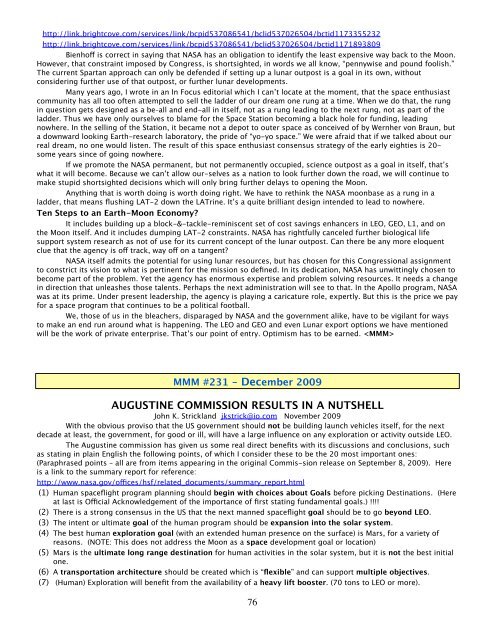Space Transportation - mmmt_transportation.pdf - Moon Society
Space Transportation - mmmt_transportation.pdf - Moon Society
Space Transportation - mmmt_transportation.pdf - Moon Society
You also want an ePaper? Increase the reach of your titles
YUMPU automatically turns print PDFs into web optimized ePapers that Google loves.
http://link.brightcove.com/services/link/bcpid537086541/bclid537026504/bctid1173355232<br />
http://link.brightcove.com/services/link/bcpid537086541/bclid537026504/bctid1171893809<br />
Bienhoff is correct in saying that NASA has an obligation to identify the least expensive way back to the <strong>Moon</strong>.<br />
However, that constraint imposed by Congress, is shortsighted, in words we all know, “pennywise and pound foolish.”<br />
The current Spartan approach can only be defended if setting up a lunar outpost is a goal in its own, without<br />
considering further use of that outpost, or further lunar developments.<br />
Many years ago, I wrote in an In Focus editorial which I can’t locate at the moment, that the space enthusiast<br />
community has all too often attempted to sell the ladder of our dream one rung at a time. When we do that, the rung<br />
in question gets designed as a be-all and end-all in itself, not as a rung leading to the next rung, not as part of the<br />
ladder. Thus we have only ourselves to blame for the <strong>Space</strong> Station becoming a black hole for funding, leading<br />
nowhere. In the selling of the Station, it became not a depot to outer space as conceived of by Wernher von Braun, but<br />
a downward looking Earth-research laboratory, the pride of “yo-yo space.” We were afraid that if we talked about our<br />
real dream, no one would listen. The result of this space enthusiast consensus strategy of the early eighties is 20some<br />
years since of going nowhere.<br />
If we promote the NASA permanent, but not permanently occupied, science outpost as a goal in itself, that’s<br />
what it will become. Because we can’t allow our-selves as a nation to look further down the road, we will continue to<br />
make stupid shortsighted decisions which will only bring further delays to opening the <strong>Moon</strong>.<br />
Anything that is worth doing is worth doing right. We have to rethink the NASA moonbase as a rung in a<br />
ladder, that means flushing LAT-2 down the LATrine. It’s a quite brilliant design intended to lead to nowhere.<br />
Ten Steps to an Earth-<strong>Moon</strong> Economy?<br />
It includes building up a block-&-tackle-reminiscent set of cost savings enhancers in LEO, GEO, L1, and on<br />
the <strong>Moon</strong> itself. And it includes dumping LAT-2 constraints. NASA has rightfully canceled further biological life<br />
support system research as not of use for its current concept of the lunar outpost. Can there be any more eloquent<br />
clue that the agency is off track, way off on a tangent?<br />
NASA itself admits the potential for using lunar resources, but has chosen for this Congressional assignment<br />
to constrict its vision to what is pertinent for the mission so defined. In its dedication, NASA has unwittingly chosen to<br />
become part of the problem. Yet the agency has enormous expertise and problem solving resources. It needs a change<br />
in direction that unleashes those talents. Perhaps the next administration will see to that. In the Apollo program, NASA<br />
was at its prime. Under present leadership, the agency is playing a caricature role, expertly. But this is the price we pay<br />
for a space program that continues to be a political football.<br />
We, those of us in the bleachers, disparaged by NASA and the government alike, have to be vigilant for ways<br />
to make an end run around what is happening. The LEO and GEO and even Lunar export options we have mentioned<br />
will be the work of private enterprise. That’s our point of entry. Optimism has to be earned. <br />
MMM #231 - December 2009<br />
AUGUSTINE COMMISSION RESULTS IN A NUTSHELL<br />
John K. Strickland jkstrick@io.com November 2009<br />
With the obvious proviso that the US government should not be building launch vehicles itself, for the next<br />
decade at least, the government, for good or ill, will have a large influence on any exploration or activity outside LEO.<br />
The Augustine commission has given us some real direct benefits with its discussions and conclusions, such<br />
as stating in plain English the following points, of which I consider these to be the 20 most important ones:<br />
(Paraphrased points – all are from items appearing in the original Commis-sion release on September 8, 2009). Here<br />
is a link to the summary report for reference:<br />
http://www.nasa.gov/offices/hsf/related_documents/summary_report.html<br />
(1) Human spaceflight program planning should begin with choices about Goals before picking Destinations. (Here<br />
at last is Official Acknowledgement of the importance of first stating fundamental goals.) !!!!<br />
(2) There is a strong consensus in the US that the next manned spaceflight goal should be to go beyond LEO.<br />
(3) The intent or ultimate goal of the human program should be expansion into the solar system.<br />
(4) The best human exploration goal (with an extended human presence on the surface) is Mars, for a variety of<br />
reasons. (NOTE: This does not address the <strong>Moon</strong> as a space development goal or location)<br />
(5) Mars is the ultimate long range destination for human activities in the solar system, but it is not the best initial<br />
one.<br />
(6) A <strong>transportation</strong> architecture should be created which is “flexible” and can support multiple objectives.<br />
(7) (Human) Exploration will benefit from the availability of a heavy lift booster. (70 tons to LEO or more).<br />
76















